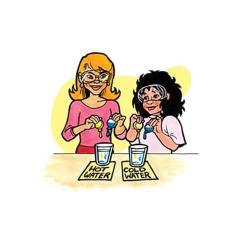Source Institutions
Source Institutions
Add to list Go to activity

Learners observe and conduct experiments demonstrating the different properties of hot and cold materials. In a demonstration, learners observe that food coloring mixes faster in hot water than in cold. In a second demonstration, learners observe that air in a bottle expands when heated. As an activity, learners examine the behavior of air inside bottles submerged in hot and cold water. Use these experiments to introduce the molecular properties of matter and the process of phase changes. The demonstrations can also be conducted as individual activities. [Activity is publicly available through a web crawler capture on Archive.org. Activity write-up only, images are unavailable.]
- 5 to 10 minutes
- 30 to 45 minutes
- $1 - $5 per group of students
- Ages 6 - 14
- Activity, Demonstration, Experiment/Lab Activity
- English
Quick Guide
Materials List (per group of students)
- Hot tap water
- Cold water
- Blue food coloring
- Yellow food coloring
- Hot water
- Cold Water
- 3 Wide clear plastic cups
- 2 Tall clear plastic cups
- 1 Wide clear plastic cup
- Plastic bottle with lid, ½ pint or ½ liter
- Bubble solution (made with dishwashing liquid, sugar, and water)
- Plastic bottle, ½ pint or ½ liter
- Student Activity Sheet
Subjects
-
Physical Sciences
-
Heat and Thermodynamics
- Heat and Temperature
-
States of Matter
- Changes of Phase
- Structure and Properties of Matter
-
Heat and Thermodynamics
-
The Nature of Science
-
The Scientific Process
- Asking Questions
- Conducting Investigations
- Gathering Data
-
The Scientific Process
Audience
To use this activity, learners need to:
- see
- touch
Learning styles supported:
- Involves hands-on or lab activities
Other
Components that are part of this resource:
This resource is part of:
Access Rights:
- Free access
By:
- Kessler, James H. ; Galvan, Patricia M.
Rights:
- All rights reserved, American Chemical Society, 2007
